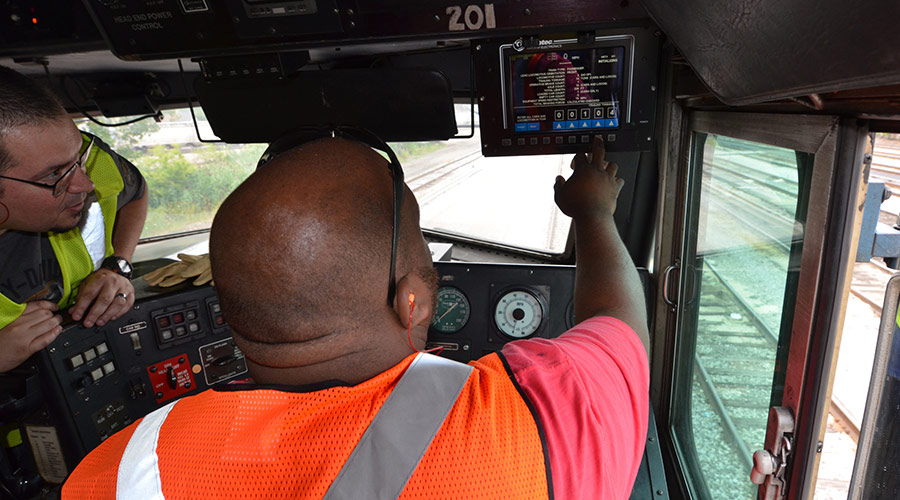Stay updated on news, articles and information for the rail industry
March 2013
Rail News: PTC
Class I railroads rate the state of positive train control
— by Jeff Stagl, Managing Editor
There's still a lot of work that needs to be accomplished by U.S. Class Is to implement positive train control (PTC) systems by the federally mandated deadline of Dec. 31, 2015. And there's one thing executives who head PTC implementation are fairly certain won't be finished by then: getting all systems in place and functioning as intended, and ensuring they're fully interoperable.
"From an industry perspective, 2015 is really not achievable," says Tom Schnautz, director of advanced train control systems for Norfolk Southern Railway. "We're doing as much as we can to try to achieve that date. But we'll finish when we finish. The discussion will turn to how late we'll be."
The primary reasons? "Significant technical and programmatic issues" associated with the design, development, testing, integration and deployment of PTC systems, as described by Federal Railroad Administration (FRA) officials in their implementation status report that was submitted to Congress in August 2012.
"Given the current state of development and availability of the required hardware and software, along with deployment considerations, most railroads will likely not be able to complete full ... implementation of PTC by Dec. 31, 2015," the report stated, adding that only partial deployment could be accomplished by the deadline.
The technical obstacles cited by railroads include the availability of communications spectrum; radios; design specifications; back office servers and dispatch systems; track database verifications; installation engineering; and system reliability. Programmatic issues include budgeting and contracting, and stakeholder availability.
PTC isn't one complete system, it's a "system of systems," says Frank Lonegro, who on Jan. 1 became CSX Corp.'s vice president of mechanical after serving as president of CSX Technology for five years.
"There are 30 moving parts, and most of them didn't exist. Maybe three did when all this started," he says. "The clear answer as to whether this all can be completed in time is, 'No.'"
In addition, PTC is a complex and developing technology, not an off-the-shelf system or software, said Union Pacific Railroad Assistant Vice President of Corporate Communications Tom Lange in an email. Moreover, because so much rail traffic is interchanged, all PTC systems must be interoperable, he said, adding that achieving interoperability is a "huge task."
"It is well known that the implementation date poses some big challenges for us and the industry," said Lange.
The House and Senate last year considered measures that would have extended the federal deadline by three to five years to provide railroads more time to implement PTC, but those measures died in the previous Congress. At this early stage in the new Congress, it's uncertain whether new legislative attempts will be made this year to extend the deadline.
The Class Is' PTC implementers hope 2013 brings an extension, as well as the availability of more key components for programs. They'd welcome some funding help, as well, for work that collectively will cost large roads more than $7 billion.
In the meantime, the implementers will continue to peck away at what's become a daunting task to develop, test, install and integrate all the pieces of their systems while the deadline remains fixed at less than three years away.
"We are making a good-faith effort to meet the 2015 deadline," said Lange.
Advances And Anxiety
So is Kansas City Southern Railway Co. (KCSR). The Class I's PTC implementers are "working with all possible diligence" in an effort to finish in time, KCSR officials said in an email.
So far, the Class I has made "significant progress" in many critical areas of deployment, including the installation of a portion of the necessary onboard equipment for locomotives, wayside signal and switch monitoring facilities, and wireless communication infrastructure, they said.
Implementers are working to integrate the back office suite of computer application systems, which include new applications specific to the PTC system and enhancements to integrate existing applications with the system.
The integration is a primary focus in 2013 because of the "complexity and uncertainty of this part of the project," KCSR officials said, adding that "quite a bit" of the work already has been accomplished.
KCSR's implementers also continue to play a role on several industry teams that are working on various activities, including documenting the common elements of the required safety case for the PTC system; analyzing and predicting the 220 MHz spectrum bandwidth requirements in critical, high-volume locations; and participating in frequency coordination and radio channel assignment engineering in locations where multiple railroads operate in close proximity to one another.
"While [we] continue to invest in and bring on line the early elements of a future PTC system … [we] continue to have concerns about the readiness of proven, interoperable technology that would be needed for PTC implementation across the entire industry," KCSR officials said.
Location(s), location(s), location(s)
Ditto for NS. The installation of wayside equipment is the Class Is' most concerning aspect of PTC implementation, in part because stand-alone wayside interface unit (WIU) technology hasn't yet matured, says NS' Schnautz.
In addition, the sheer volume of locations involved — two-thirds of the railroad's 20,000-mile network features wayside infrastructure — is daunting, he says. Only about 10 percent of required wayside work has been completed so far.
"Some components aren't yet available, such as PTC software. I'd say PTC software is the second most concerning thing," says Schnautz. "There needs to be some development so we can start testing, and then validate it and get approval from the FRA. There's nothing to turn on."
PTC software is expected to be available in late summer, meaning lab testing could begin in fall to "see if we find any defects," and then field testing could start sometime next year, says Schnautz.
For the remainder of 2013, NS plans to continue installing wayside equipment and equipping locomotives with onboard devices — as of early February, that work was more than 40 percent completed. The railroad expects to double the rate of wayside installations as processes associated with the work improve, says Schnautz.
Because not all components are available yet for locomotives, the motive power that receives onboard devices will need to be reworked at some point. Wayside installations eventually will have to be reworked, too, he says.
NS also needs to determine the optimal timeframe and method to train tens of thousands of employees — essentially, the Class I's "entire population" — on how to operate and maintain the PTC system, he says.
"We're caught between a huge number of people to train vs. training them too far ahead. It's like training a 5-year-old to drive, and then they have to wait 11 years," says Schnautz. "We likely will train more people when we're closer to activating the system."
NS also is trying to get to the point at which it can submit a PTC safety plan to the FRA. Class Is have submitted a draft outline to the FRA as a group because they're all using interoperable systems, but "we need to fill in pieces for NS," says Schnautz.
Submission For The Mission
BNSF Railway Co. already has submitted a safety plan to the FRA for approval and system certification of the Electronic Train Management System (ETMS®), Version 7.0. The FRA received BNSF's petition for approval in November 2012 and is expected to take final action sometime later this year.
BNSF is seeking plan approval and system certification of the non-vital processor-based train control system safety overlay for use in its network where ETMS is implemented. ETMS Version 7.0 is designed to protect against the consequences of train-to-train collisions, enforce compliance with civil and temporary speed limits, provide safety for roadway workers operating within authority limits and prevent train movements through improperly aligned switches.
Currently, BNSF has begun wayside installations in more than half of the 78 subdivisions impacted by implementation, including those in southern California. BNSF and UP are working with Metrolink to implement PTC in the Los Angeles area well before the federally mandated deadline — a primary reason BNSF submitted the safety plan to the FRA. Pilot testing of wayside equipment reliability will be conducted both in southern California and northern Illinois.
This year, BNSF has budgeted $250 million to continue implementing PTC compared with $300 million in 2012.
UP — which spent about $750 million on PTC from 2008 through 2012 — has budgeted $450 million for 2013. The original estimate of $1.4 billion to implement the technology now has risen by about $600 million, says UP's Lange.
"We estimate that we will spend $2 billion to implement PTC and hundreds of millions more each year to maintain it," he says.
Falling By The Wayside
CSX's total price tag stands at $1.7 billion. And more than half of that will be spent on the portion of the Class I's PTC system that's the most daunting in terms of cost and scope: wayside installations.
CSX needs to install WIUs and other wayside equipment along 16,000 track miles; replace non-microprocessor-based signals along 6,700 track miles; and install a power source and communications equipment at 1,000 switch locations in dark territory. In addition, each dark territory location requires a 911 address, WIU and radio, says CSX's Lonegro.
So far, the Class I has completed more than a quarter of the required wayside improvements. The remainder is expected to be accomplished at an accelerated rate as components become available.
In terms of equipping locomotives with PTC components, CSX has completed "provisional installations" on 1,700 of the 3,600 road units that require equipment, or about 90 percent of the Class I's fleet. Provisional installations include all pre-wiring work, antennas and mounting brackets. Through the remainder of the year, the railroad plans to begin full installations on the remaining 1,900 locomotives and start complete installations on the 1,700 partially provisioned units.
For the office/back office aspect of CSX's PTC system, Wabtec Corp. continues to develop the hardware and software for the train management computers. A back office system will serve as a hub and translator between each railroad's unique dispatching and Management Information Systems infrastructure.
Development challenges include configuring dispatch systems to provide the granularity PTC requires, Lonegro says. Since PTC is a braking control system, it needs to know exactly where an operating authority ends and where a train needs to start braking before it encroaches on the next authority.
In terms of communications, CSX continues to participate in PTC 220 L.L.C., a holding company owned by the seven Class Is that is trying to acquire and allocate 220 MHz radio spectrum. The 220 MHz radio will be standard for each Class I to ensure interoperability.
Meanwhile, MeteorComm L.L.C. — which is owned by BNSF, CSX, NS and UP — continues to develop the 220 MHz radios and radio communication software for interoperability. The company now is producing radios for locomotives, base stations and waysides, says Lonegro, adding that quantity and quality will need to be ensured. The messaging software — which is key to interoperability — still is being developed, he says.
Hurry Up And Wait
Waiting for numerous components to be developed so they can be lab and field tested, and then eventually be implemented, is an ongoing theme for all Class Is as they hustle to meet the current deadline. The waiting game also involves the outcome of a second notice of proposed rulemaking involving PTC that the FRA issued late last year.
The FRA proposes to revise regulatory provisions related to a "de minimis" exception to the installation of PTC systems and applications to yard-related movements. The proposed rulemaking also would revise existing regulations related to en route failures of a PTC system and discontinuances of signal systems once a PTC system is installed, and make additional technical amendments to regulations governing grade crossing warning systems and signal systems, including PTC.
While the Class Is' PTC implementers await the conclusion of the rulemaking, they're also anxious to know if the feds decide to extend the deadline. It might be a while before the new Congress takes up any measures. President Obama also needs to choose a new U.S. transportation secretary, says Lonegro.
"We are talking to all the right committees in the House and Senate," he says. "We're waiting for the dust to settle."
If an extension eventually passes muster, anything less than three years wouldn't be very beneficial, says Lonegro.
"We need a three-, four- or five-year extension," he says.
Despite many overriding concerns, Class Is so far have displayed an unprecedented level of cooperation while pursuing PTC, says Lonegro. In addition, some Class I executives have made implementation their life's work and are focusing solely on adopting the technology, which ultimately will make railroads safer, he says.
"People have dedicated their careers to this," says Lonegro.


 2025 MOW Spending Report: Passenger-rail programs
2025 MOW Spending Report: Passenger-rail programs
 Gardner steps down as Amtrak CEO
Gardner steps down as Amtrak CEO
 Guest comment: Oliver Wyman’s David Hunt
Guest comment: Oliver Wyman’s David Hunt
 Women of Influence in Rail eBook
Women of Influence in Rail eBook
 railPrime
railPrime







